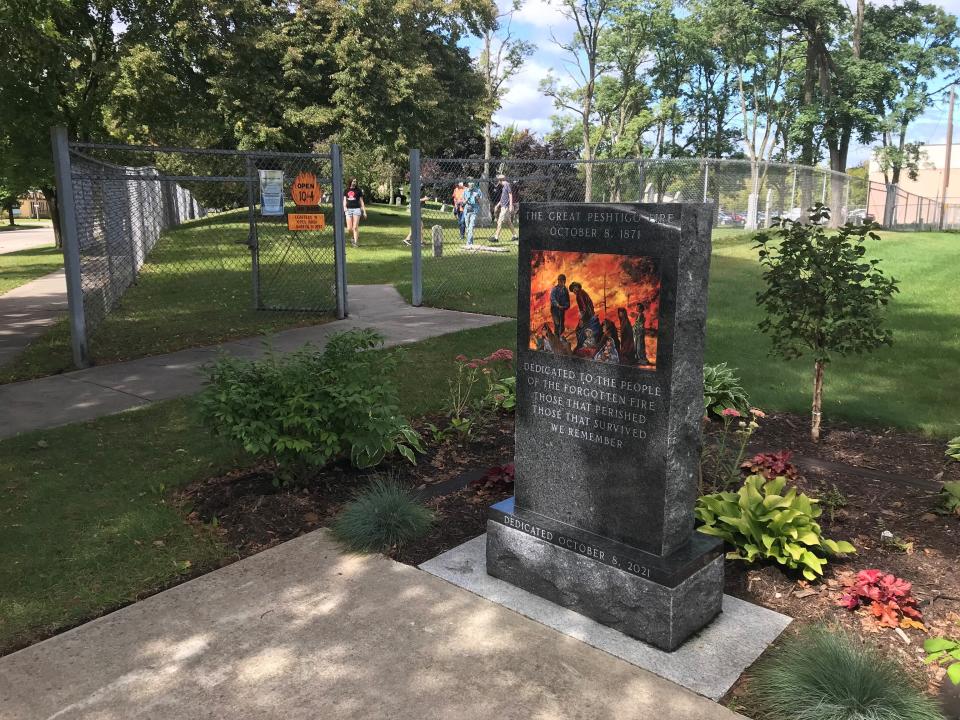In a summer of historic wildfires, the Peshtigo Fire remains deadliest in U.S. history
Across North America this summer, wildfires have burned over 13 million hectares of land in Canada, covered the continental U.S. in thick blankets of smoke and threatened rare species in the Mojave Desert.
Most recently, wildfires in Maui last week killed 93 people, with the possibility for more as efforts to find and recover victims begin. Already, the Maui wildfires are the deadliest in the U.S. in over 100 years, displacing hundreds of Hawaiians and burning 250 buildings, including historic and cultural sites, in the town of Lahaina.
The highest death toll from wildfires in U.S. history was in 1871 in Peshtigo, Wisconsin.
When and where did the Peshtigo Fire happen?
On the night of October 8, 1871, in Peshtigo, a lumber town about seven miles southwest of the Michigan-Wisconsin border, hundreds of people died: burned by fire, suffocating from smoke, or drowning or succumbing to hypothermia while trying to shelter in the Peshtigo River.
But the fire also raged across Oconto and Marinette counties into Michigan's Upper Peninsula, while another blaze burned across the bay of Green Bay in Brown, Door, and Kewaunee counties.
"A pall of smoke" hung over Appleton, Green Bay, Marinette and other cities for miles, according to a 1921 story in the Milwaukee Journal.
What caused the Peshtigo Fire?
The town had struggled with small fires during the summer of 1871. Conditions had been unusually dry, and plenty of sparks were flying: from the train running from Peshtigo to the harbor, from smoldering campfires, from farmers and railway workers clearing land.
On the night of October 8, a strong wind swept up small fires, carrying them to Peshtigo and transforming them into "tornadic winds," Helen McNulty, a curator at the Peshtigo Fire Museum, told the Oconto County Reporter.
The wind eventually reached 100 mph and spun in a counterclockwise circle, creating a firestorm that was 3 miles across and 1,000 feet high.
"If I could describe it, it's like a tornado, only it's fire," Peshtigo Museum volunteer Sally Kahl told the Milwaukee JourSentinel. "A tornado moves on … a firestorm doesn't move on. It stays in one place until it burns everything."
More: 150 years ago, the deadliest wildfire in American history devastated Peshtigo, northeast Wisconsin
The drought that parched Peshtigo that summer affected much of the Midwest, causing other wildfires.
Fires that same day killed 500 in central Michigan and 300 in the Great Chicago Fire. The fire in Chicago also left an estimated 100,000 people homeless.
How many people died?
While the National Fire Protection Association estimates the Peshtigo Fire's death toll at 1,152, some believe as many as 2,500 people may have been lost.
It's impossible to know for certain, as the fire destroyed records and burned many people beyond recognition. One mass grave contained 350 people who couldn't be identified.
“There were so many that were just cremated on the spot,” said McNulty.

Does Peshtigo still exist today?
The fire, which destroyed 400 square miles of land, wiped out Peshtigo. The only structure left standing was a single house.
Survivors from the town remained when a local business magnate promised to rebuild the woodwares factory. That never happened, but Peshtigo's sawmill was rebuilt near the completed railroad.
Today, Peshtigo is a city of about 3,400 and maintains a museum in an old church near where hundreds of fire victims are buried. On its website, Peshtigo proclaims itself "The City Rebuilt from Ashes."
Contributing: Kent Tempus from the Oconto County Reporter; Claire Thornton from USA TODAY; Chelsey Lewis from the Milwaukee Journal-Sentinel.
Rebecca Loroff is a breaking and trending news reporter for USA TODAY NETWORK-Wisconsin. Contact her at rloroff@gannett.com.
This article originally appeared on Appleton Post-Crescent: In a summer of historic wildfires, the Peshtigo Fire remains deadliest


